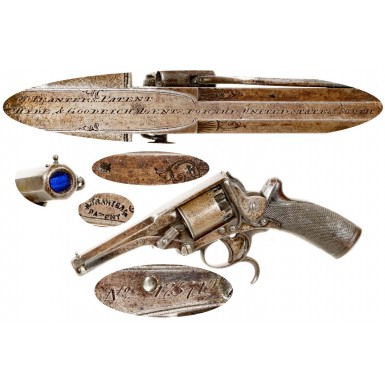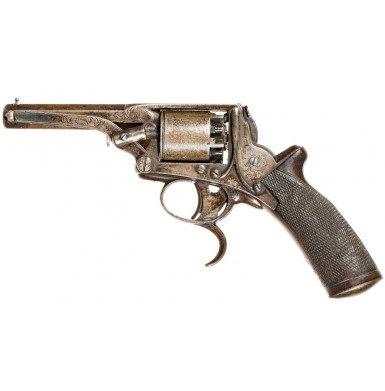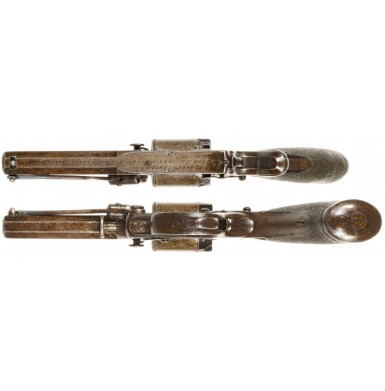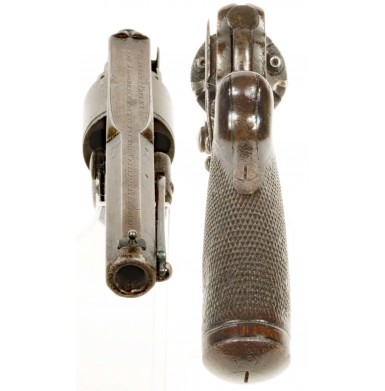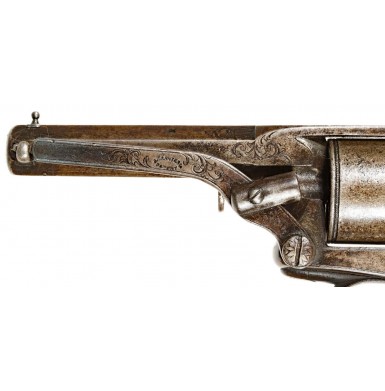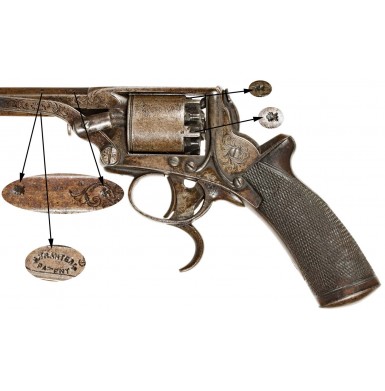New Orleans Hyde & Goodrich Retailer Marked 3rd Model Tranter Revolver - Rare
- Product Code: FHG-2081-SOLD
- Availability: In Stock
-
$4,500.00
The revolvers produced by English gunmaker William Tranter were some of the most advanced and modern handgun designs to see use by the Confederacy during the course of the American Civil War. Tranterwas born in 1816 and died in 1890. During his working life he was one of the most prominent Gun, Rifle & Pistol Makersin the Birmingham (England) gun trade. He went into business for himself circa 1840, after completing his apprenticeship with Hollis Brothers & Co., which he had begun in 1830. Tranter continued in the trade until 1885, just five years before his death. In 1840, after spending a decade learning the gun trade at Hollis Bros & Co. (later Hollis & Sheath), Tranter bought the established gun making business of Robert Dugard at 29 ½ Whitehall Street. Over the next decade, he worked for himself and was also involved in joint ventures with his old employers John & Isaac Hollis as well as with Isaac Sheath. By 1850, he had located his primary business at 50 Loveday Street, where he was listed in a period directory as having “shops, sheds, steam machinery, yard & premises”. Tranter secured his first British patent related to firearms in October of 1849 when he registered a “pepperbox mechanism and lever catch for pistol locks”. In January 1853, he registered British Patent Number 212 (1853) for a pair of “self-cocking” pistol mechanisms and a safety mechanism. In December of the same year, he registered designs for a double-action revolver mechanism, lubricated bullets and wadding, and a breech loading mechanism; all of which were covered by Patent Number 2921 (1853). In August of 1856, he registered the designs for a “double trigger revolver mechanism”, along with several other designs; all of which were covered by British Patent Number 1913 (1856). Tranter continued patenting firearm designs as late as 1887, even though he was no longer directly active in the gun trade on a day-to-day basis.
Tranter’s most successful series of arms were his “self-cocking” revolvers, which were initially introduced in 1853. The earliest revolvers utilized Robert Adams’ patent for a solid, one-piece frame and barrel that were machined from a single steel forging. Tranter’s initial production run of revolvers included both Adams 1851 Patent lock works, and Tranter's own patented lock works. The original “Tranter” type revolvers, known to collectors as 1stModel Tranterrevolvers had no provision for a fixed loading lever. The lever swiveled on a stud that projected from the left side of the frame, which had no provision to retain the lever when it was mounted on the revolver. The lever was intended to be stored in a case or carried in the pocket; hardly a practical solution if the user actually had to reload the revolver in the field. Most of these guns were manufactured on Adams Patent frames and have Adams Patent serial numbers (really patent tracking numbers to pay royalties to Adams) and these numbers are followed by a Y-suffix. The 2ndModel Tranter revolvers also had a pin on the frame that allowed the attachment of a removable loading lever, but the pin had a small projection that allowed the lever to remain attached to the gun unless a notch in the lever was aligned with the stud projection to remove it. The later production examples of these guns, manufactured after approximately 1856, have Tranter Patent serial numbers and end with a T-suffix. These guns not only include Tranter Patent lock works, but also a newly improved version of the Adams solid frame, which was patented by Tranter in 1856. At this point, Tranter revolvers rarely have Adams allocated serial numbers. The 3rdModel Tranter revolvers had a more permanently attached loading lever, which was secured by a screw. The 3rdModels appear to have all been produced in the T-suffix Tranter serial number range. All three of these models were based on his “double-trigger” system (initially referred to as his “hesitating mechanism” on the early production guns), which utilized a second “trigger” under the trigger guard to rotate the cylinder and cock the hammer. The trigger inside the triggerguard was used to trip the sear and release the hammer to fire the revolver. The 4thModel Tranter revolvers, which were introduced in 1856 and are all in the Tranter T-suffix series as well, used a single trigger and utilized a lock work that would be referred to as a conventional “double action” mechanism today. A particularly rare variation of the Tranter action is known as the “Treble Action” revolver. It used the double-trigger system combined with what would be called a conventional double action lock work. This allowed the gun to be used like all previous double-trigger Tranter’s, with the lower trigger cocking the hammer and rotating the cylinder, and the inner trigger releasing the hammer. It was also possible to cock the hammer manually (which could not be done on 1stthrough 3rdModel Tranters) and then release the hammer with the inner trigger. The most interesting feature was that if the lower trigger was pulled briskly to the rear it would operate the gun like a double action only revolver, by firing the revolver at the end of the lower trigger’s travel. These “Treble Action” Tranters are instantly recognizable because they are the only double-trigger Tranter revolvers to feature a hammer spur. It is also worth noting that almost all of the known examples of these “Treble Action” guns have American retailer markings, so apparently this model was particularly popular in America. All the Tranter revolver patterns were produced in a variety of calibers, with 54-Bore (.442) “Holster Size” and 120-Bore (.338) “Pocket Size” revolvers being the most commonly encountered calibers and frame sizes, with the mid-sized 80-Bore (.387) “Belt Size” being less often encountered. Some of the guns were also produced in the exceptionally large and powerful 36 and 38 bore sizes, which were larger versions of the holster size guns, and were about .50 caliber! Barrel lengths varied as well, with the larger caliber arms typically having longer barrels, and the smaller caliber guns having shorter barrel. All of the guns were 5-shot percussion revolvers, and typically featured checkered one-piece walnut grips, although smooth wooden grips and other grip materials are known to have been used on a special order basis. Tranter even produced some revolving rifles based upon the same mechanisms and patents, with some of those in calibers as large as .577.
The Tranter patent revolver was the primary competitor with the Adams and Adams-Beaumont patent revolvers in England and was also exported widely. Pre-Civil War Tranter revolvers are known with US retailer marks, indicating that his designs were at least somewhat successful in the United States during the antebellum period. The majority of the retailer marked guns are from the southern states, with the largest majority of them being marked by New Orleans retailers. Based upon extant examples, the firm of Hyde & Goodrich (later Thomas, Griswold & Co) appears to have been the primary importer of Tranter Patent revolvers into the southern United States. Most of these retailer-marked guns were sold cased with accessories, although some guns were certainly sold without the expensive casings and accouterments. During the course of the American Civil War, it appears that the importation of Tranter revolvers was somewhat limited, at least in terms of Confederate central government purchases. However, period advertisements in the south and extant examples with southern provenance make it clear that the guns were imported by blockade-runners as speculative items for sale in the south. Such famous Confederates as General John Hunt Morgan (3rdModel #3758T), General J.E.B. Stuart (4thModel #8673T) and General John Magruder and Colonel Dabney H. Maury (3rdModel #7993T), who served on the staff of General Earl Van Dorn, all owned documented 54-Bore Tranter revolvers. The famous “Pratt Roll”, which lists the revolvers in the possession of Lt. Julian Pratt’s squad of troopers in Company H of the 18thVirginia Cavalry in July of 1864, lists two Tranter revolvers, with the serial numbers 15,465 and 15,476. This indicates that Tranter revolvers in the mid 15,XXX serial number range were in use by southern forces, and in the field by that time. While models are not listed in the list, it is generally assumed that these guns were either 3rdof 4thmodel revolvers and were likely 54-Bore. Other Tranter revolvers with southern provenance include guns which are retailer marked by T.W. Radcliffe of Columbia, SC. Additionally, a March 10, 1863 advertisement in the Richmond Times Dispatchfor H. E. Nichols of Columbia, SCread in part: “Fine English Revolvers. Just received from England, six Tranter’s fine revolving pistols, 80 and 120 bore. Price $220 each”. All of this evidence indicates that at least some of the Tranter revolvers produced during (as well as prior to) the American Civil War, saw Confederate use.
Dating Tranter revolvers based upon their serial numbers is somewhat problematic, as frames were sometime produced in advance and the guns completed at a later date. What we do know is that the “T” serial number suffix came into use around serial number 2200, sometime between 1854 and 1856. We also know that Tranter produced revolvers using Adams patent serial numbers and a “Y” suffix from about 1853 through about 1856. These guns appear in several serial number ranges, as assigned by Adams, including the 2X,XXX range. All “Y” suffix guns predate the Civil War by at least four or five years. From extant examples of Tranters with specific presentations, dated invoices and dates of usage associated with them, it appears that those Tranter revolvers with serial numbers through about the 20,XXX range (and possibly some of the early guns in the 21,XXX range) with T suffixes, appear to have been produced prior to the end of 1865, making them “Civil War era”. Post-Civil War southern retailer marks begin to appear in the high 20,XXX to low 21,XXX range, suggesting that these guns are likely 1865 production, or possibly slightly later. One example of a post-war A.B. Griswold retailer marked Tranter revolver is known with a Civil War period serial number, but this appears to be a case of “new old stock”, with a gun made before the end of the war being sold to the post-Civil War retailer in New Orleans.
Offered here is an incredibly scarce Hyde & Goodrich Retailer Marked 3rdModel Tranter Pocket Revolverin VERY GOODcondition. The retailer mark on this revolver is rather scarce and probably the most desirable of all the Hyde & Goodrich markings. The topstrap is engraved in two lines:
W. TRANTER,S . PATENT .
HYDE .&. GOODRICH. AGENTS FOR THE UNITED STATES SOUTH
Of the variations of Hyde & Goodrich retailer marks found on revolver, this is the most intriguing and is believed by some researchers to indicate that the gun was offered for sale sometime between the formation of the Confederacy (February of 1861) and the close of Hyde & Goodrich’s retail operations (mid-1861), when the firm became Thomas, Griswold & Company.
Hyde & Goodrich had been operating in New Orleans from about 1852, offering jewelry, silver and a variety of high-end imported and locally produced items ranging from household goods to fine English firearms. The pocket-sized revolver is 120-bore (approximately .334 caliber). The pistol is engraved on the lower right side of the frame No12,571 T, the serial number of the revolver. While Tranter’s cannot be dated specifically by serial number like Colt and Winchester firearms, based upon known extant examples that are identified or dated, I believe that this revolver was produced circa 1860, but due to the various delays associated with importing the gun, it may have been sold by Hyde & Goodrich as much as a year or more after its manufacture. I will also note that there are a small number of extant Hyde & Goodrich marked Tranter’s in the 8,XXX range (including one on display at the Confederate Memorial Hall museum in New Orleans) as well as guns in the 11,XXX-12,XXX range. It appears that the firm acquired a shipment of at least a couple dozen of the revolvers that were all produced circa 1858-1859 and marked with Hyde & Goodrich retailer information and likely tried to obtain even more of the guns as the clouds of war gathered. The left side of the frame of the gun is not marked with the typical arced two-line TRANTER’S PATENTcartouche, which is commonly encountered on later production revolvers. However, this mark is present on the removable loading lever and on the left side of the trigger.
As noted above, the revolver is in about VERY GOODcondition. The gun remains fairly crisp with strong edges and lines throughout. The gun retains some minute traces of its original blued finish in protected areas. However, the majority of the metal has a mostly smooth oxidized brown patina over a dull pewter base color, with some evenly distributed patches of age discoloration, flecks of light surface oxidation and some lightly scattered pinpricking. The 3 ½” octagonal barrel bears the expected Birmingham commercial view and proof marks on the left angled flat, just in front of the frame juncture, as well as on the cylinder between the chambers. The cylinder appears to have been color case hardened, as were most Tranter cylinders of this period and minute traces of darker mottling are visible on the otherwise mottled dark gray and pewter colored metal. The cylinder retains all its original cones (nipples), and they are all in crisp and usable condition with good edges and no significant battering or damage. The bore of the revolver rates about GOOD+ to NEAR VERY GOODas well, with sharp five-groove rifling. The bore is mottled and shows scattered areas of bright and dark metal. The bore shows patches of oxidation as well as some scattered light pitting along its length. The usual Tranter style, light foliate scroll engraving is present on the rear of the frame and at the frame to barrel junction. Light foliate engraving is present on the loading lever, with some decorative engraving at the muzzle as well. The cylinder shows boarder line engraving on its edges and rear, as well as beaded engraving along the front edge. This engraving remains clear and sharp throughout, with only the engraving at the muzzle being a little soft and worn. The left side of the frame retains the original Tranter’s patent spring safety that prevents the hammer from contacting the cones unless the trigger is pulled. Using the safety places the hammer on a pseudo “half cock” position, allowing the cylinder to be turned freely for loading. The original arbor pin retaining spring catch is also present on the forward right side of the frame. Both the safety and the arbor catch are in perfect mechanical condition. The original, screw-retained, Tranter “3rdModel” loading lever is attached to the right side of the frame. The loading lever is marked with a two-line oval cartouche that reads: W. TRANTER’S / PATENT. The lever functions smoothly and locks securely into place when not in use. What appears to be the original front sight is in place in the dovetail near the muzzle. The one-piece checkered walnut grip is in about VERY GOODcondition as well and matches the condition of the pistol perfectly. The grip is solid and free of any breaks, cracks or repairs. The checkering remains fairly crisp but does show some light to moderate wear and some dings and handling marks. The action of pistol work very well and the revolver times, indexes and locks up, exactly as it should. The revolver may be an early example of Tranter experimenting with what would become his “Treble Action” design. If the lower trigger is depressed with moderate pressure, it works as expected, cocking the revolver and indexing the cylinder, allowing the inner trigger to fire the revolver. However, if more pressure is applied at the end of the travel the hammer will fall, allowing the revolver to be used as a double-action-only revolver as well. This is the only 3rdModel Tranter I have ever encountered with this variation in the action mechanism.
Overall this is a nice, solid and scarce example of a rare Hyde & Goodrich – Agents for the United States Southretailer marked 3rdModel Tranterpercussion revolver. The gun is 100% complete, correct and period in every way, with the only replacement part being the small loading lever catch. The pistol also functions well, which is nice as the safety mechanisms of these revolvers are often broken. For any collector of secondary Confederate revolvers, this is a nice opportunity to acquire a nice southern imported Tranter with the most desirable of the Hyde & Goodrich retailer marks that was imported for sale in New Orleans just prior to the outbreak of the American Civil War.
SOLD
Tags: New, Orleans, Hyde, Goodrich, Retailer, Marked, 3rd, Model, Tranter, Revolver, Rare

